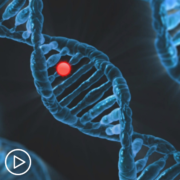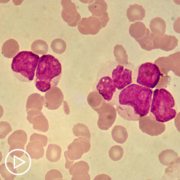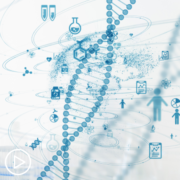Tag Archive for: FLT3-positive
What Different AML Subtypes Are More Prevalent in Certain Demographics?
What Different AML Subtypes Are More Prevalent in Certain Demographics? from Patient Empowerment Network on Vimeo.
Are some acute myeloid leukemia (AML) subtypes more common in some demographic groups? Dr. Naval Daver from the University of Texas MD Anderson Cancer Center discusses different forms of AML. Learn about the extent of knowledge about AML subtype demographics.
[ACT]IVATION TIP from Dr. Daver: “Patients, when they transformed what we call secondary AML or MDS, seemed to have a higher predilection for certain high-risk communications such as TP53, and these are best treated with ongoing frontline clinical trials at large academic centers.“
Download Resource Guide en español
Related Resources:

|

|
Transcript:
Art:
Dr. Daver, what are the different subtypes of AML, are various subtypes more prevalent in certain demographics?
Dr. Naval Daver:
The main way we have classified AML has actually been changing, so when we talk about subtypes there are actually two different classification systems like WHO and the ICC or ELM classification system. Traditionally, we have been using the ELM for prognostic classification of AML, this divides patients into three major buckets, what we call a favorable intermediate and adverse, and these are based on the underlying chromosome cytogenetics abnormalities and molecular or next-generation sequencing profile of the patients.
In general, in AML there has actually been limited data and publications regarding the demographic distribution, whether it’s regional or racial or cultural, one of the things that we do know, for example, in acute lymphoblastic leukemia is that in the Hispanic population, there seems to be higher frequency of things like FLT3-positive ALL.
But in the AML population, there actually does not seem to be, at least based on published data, huge differences in the molecular or cytogenetic presentation. We have seen some data from different countries that there may be a difference in the prevalence of communications across different regions. For example, in Japan, we do see that the incidence of FLT3 and NPM1 appears to be lower than what has been reported in the United States.
Also, we see in Europe and United States, the incidence of these mutations with FLT3, NPM1 is similar, and then we are seeing in some of the larger academic centers in the U.S., there is an enrichment of referral of patients with TP53, which is very adverse and most difficult to treat mutation, and a lot of that we think is because patients with solid tumors and with other hematological malignancies are surviving longer with the CAR-T therapies, immunotherapies, and because it is over time, they have a risk of developing second AML, which is enriched for TP53 mutation, so we do see over the last two decades that from TP53, which used to be about 5 percent to 10 percent, is now up to 20 percent to 25 percent of AML and growing in proportion because it’s better survival and solid tumors and lymphomas.
The activation tip related to this question is that in general, they don’t review discrepancies based on geography and race, and region in the molecular cytogenetics. However, we do see differences in patients who have received prior chemotherapy, radiation therapy, AML therapy for other solid tumors and lymphoma.
These patients, when they transformed what we call secondary AML or MDS, seemed to have a higher predilection for certain high-risk communications such as TP53, and these are best treated with ongoing frontline clinical trials at large academic centers.
Share Your Feedback About [ACT]IVATED AML
What Is FLT3-Mutated Acute Myeloid Leukemia?
What Is FLT3-Mutated Acute Myeloid Leukemia? from Patient Empowerment Network on Vimeo.
Some acute myeloid leukemia (AML) patients may have an FLT3 mutation. Dr. Catherine Lai from Penn Medicine shares insight about the two types of FLT3 mutation, treatment options for FLT3-mutated AML, and progress in research
[ACT]IVATION TIP from Dr. Lai: “Ask your oncologist, if your FLT3 mutation testing was done, ask which type of mutation they have, if it’s the ITD or TKD, if they are FLT3-positive and what the drug options are available for them.”
Download Resource Guide en español
Related Resources:

|

|

BIPOC Patients Living with AML | Mortality Rate and Favorable Genetics |
Transcript:
Art:
Dr. Lai, what is FLT3 mutated AML and what treatment options do patients with FLT3 AML have?
Dr. Catherine Lai:
Yeah, so FLT3, FLT3 mutations occur in about 25 percent to 30 percent of patients. There are two different types of FLT3 mutations. There’s a FLT3, the ITD mutation and the FLT3, the TKD mutation. They just are there, different parts of the mutation on different parts of the cell, and so how I think about that is, if you think of a leukemia cell and each leukemias has a different color-coded flag, and so the FLT3 mutation I think of is just having a specific color coding, and while a FLT3 mutation in general does predict for a worse prognosis for patients, we do have targeted treatments. In a newly diagnosed setting, we have midostaurin (Rydapt), which is added to intensive chemotherapy for those fit enough to tolerate it.
And in the relapsed refractory setting, we have a medication called gilteritinib (Xospata), which is given as a single agent, so a chemo pill, and that was compared to all types of chemotherapy, both intensive and low intensive chemotherapy, and that pill alone and the refractory and relapsed setting was better than either of the chemotherapies alone, so we’ve made a lot of progress for the FLT3-mutated patients to the majority of those patients end up going to transplant if possible, and so there are studies that are looking at FLT3 inhibitors in the post-transplant setting to also help improve long-term survival and overall survival. So the activation tip from that standpoint, that is to ask your oncologist, if your FLT3 mutation testing was done, ask which type of mutation they have, if it’s the ITD or TKD, if they are FLT3-positive and what the drug options are available for them.




